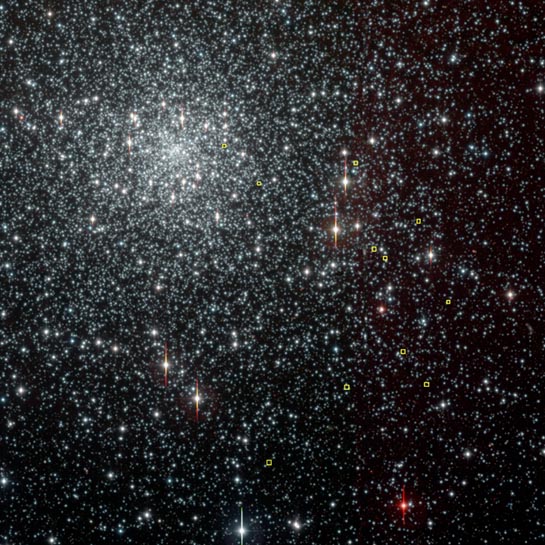
Globular Star Cluster
RA 17h 40m 42.10s Dec -53° 40' 27.18"
Ara
7000 light years
10.98 x 10.98 arcminutes
North is 0.1° right of vertical
ESO
August 10, 2006
Other images: 2018 2007 2006 2006 2003
ABOUT THIS IMAGE:
This image shows the nearby metal-poor globular cluster NGC 6397, located at a distance of approx. 7,200 light-years in the southern constellation Ara. Some of the FLAMES-UVES target stars are highlighted with yellow squares. The photo is a composite of exposures in the B-, V- and I-bands obtained in the frame of the Pilot Stellar Survey with the Wide-Field-Imager (WFI) camera at the 2.2-m ESO/MPI telescope at the ESO La Silla Observatory. It was prepared and provided by the ESO Imaging Survey team. The spikes seen at some of the brighter stars are caused by the effect of overexposure (CCD "bleeding").
Analyzing a set of stars in a globular cluster with ESO's Very Large Telescope, astronomers may have found the solution to a critical cosmological and stellar riddle. Until now, an embarrassing question was why the abundance of lithium produced in the Big Bang is a factor 2 to 3 times higher than the value measured in the atmospheres of old stars. The answer, the researchers say, lies in the fact that the abundances of elements measured in a star's atmosphere decrease with time.
"Such trends are predicted by models that take into account the diffusion of elements in a star", said Andreas Korn, lead-author of the paper reporting the results in this week's issue of the journal Nature [1] [2]. "But an observational confirmation was lacking. That is, until now."
Lithium is one of the very few elements to have been produced in the Big Bang. Once astronomers know the amount of ordinary matter present in the Universe [3], it is rather straightforward to derive how much lithium was created in the early Universe. Lithium can also be measured in the oldest, metal-poor stars, which formed from matter similar to the primordial material. But the cosmologically predicted value is too high to reconcile with the measurements made in the stars. Something is wrong, but what?
Diffusive processes altering the relative abundances of elements in stars are well known to play a role in certain classes of stars. Under the force of gravity, heavy elements will tend to sink out of visibility into the star over the course of billions of years.
"The effects of diffusion are expected to be more pronounced in old, very metal-poor stars", said Korn. "Given their greater age, diffusion has had more time to produce sizeable effects than in younger stars like the Sun."
The astronomers thus set up an observational campaign to test these model predictions, studying a variety of stars in different stages of evolution in the metal-poor globular cluster NGC 6397. Globular clusters [4] are useful laboratories in this respect, as all the stars they contain have identical age and initial chemical composition. The diffusion effects are predicted to vary with evolutionary stage. Therefore, measured atmospheric abundance trends with evolutionary stage are a signature of diffusion.
Eighteen stars were observed for between 2 and 12 hours with the multi-object spectrograph FLAMES-UVES on ESO's Very Large Telescope. The FLAMES spectrograph is ideally suited as it allows astronomers to obtain spectra of many stars at a time. Even in a nearby globular cluster like NGC 6397, the unevolved stars are very faint and require rather long exposure times.
The observations clearly show systematic abundance trends along the evolutionary sequence of NGC 6397, as predicted by diffusion models with extra mixing. Thus, the abundances measured in the atmospheres of old stars are not, strictly speaking, representative of the gas the stars originally formed from.
"Once this effect is corrected for, the abundance of lithium measured in old, unevolved stars agrees with the cosmologically predicted value", said Korn. "The cosmological lithium discrepancy is thus largely removed."
"The ball is now in the camp of the theoreticians," he added. "They have to identify the physical mechanism that is at the origin of the extra mixing."
Notes:
[1] "A probable stellar solution to the cosmological lithium discrepancy", by A.J. Korn et al.
[2] The team is composed of Andreas Korn, Paul Barklem, Remo Collet, Nikolai Piskunov, and Bengt Gustafsson (Uppsala University, Sweden), Frank Grundahl (University of Aarhus, Denmark), Olivier Richard (Université Montpellier II, France), and Lyudmila Mashonkina (Russian Academy of Science, Russia).
[3] High-precision measurements of the matter content of the Universe were made in recent years by studying the cosmic microwave background.
[4]
Globular clusters are large aggregates of stars; over 100 are known in
our galaxy, the Milky Way. The largest contain millions of stars. They
are some of the oldest objects observed in the Universe and were presumably
formed at about the same time as the Milky Way Galaxy, a few hundred million
years after the Big Bang.